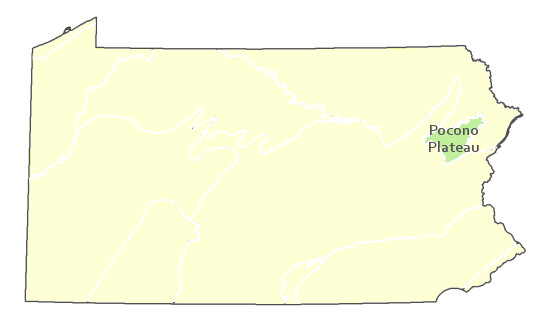Sweet-gale – Leatherleaf Shrub Fen
System: Palustrine
Subsystem: Shrubland
PA Ecological Group(s): Peatland Wetland
Global Rank:GNR
![]() rank interpretation
rank interpretation
State Rank: S1
 - Sedge Shrub Fen\LongPond-Sweetgale.jpg)
General Description
Leatherleaf (Chamaedaphne calyculata) is dominant or co-dominant with sweet-gale (Myrica gale) and the shrubs are typically one-meter high and very dense. Other low shrubs like rhodora (Rhododendron canadense), sheep laurel (Kalmia angustifolia), black chokeberry (Photinia melanocarpa), Labrador-tea (Rhododendron groenlandicum), and bog laurel (Kalmia polifolia) are common. Tall shrubs like highbush blueberry (Vaccinium corymbosum), swamp azalea (Rhododendron viscosum), witherod (Viburnum cassinoides), alder (Alnus spp.), and arrow-wood (Viburnum recognitum) as well as red maple (Acer rubrum), red spruce (Picea rubens), tamarack (Larix laricina), and pitch pine (Pinus rigida) saplings are scattered throughout. Sedges are common and may include sedge (Carex trisperma), sedge (Carex canescens), tussock sedge (Carex stricta) and sedge (Carex utriculata). Other herbaceous species may include pitcher-plant (Sarracenia purpurea), sundews (Drosera spp.), coastal mannagrass (Glyceria obtusa), and water bulrush (Schoenoplectus subterminalis). hummock and hollow microtopography is pronounced with narrow and deep pools. Sphagnum moss (Sphagnum spp.) forms a thick carpet on hummocks.
Rank Justification
Critically imperiled in the jurisdiction because of extreme rarity or because of some factor(s) such as very steep declines making it especially vulnerable to extirpation.
Identification
- Dominated by sweet-gale (Myrica gale) and leatherleaf (Chamaedaphne calyculata var. angustifolia)
- Occurs within Pocono Plateau
- Hummock and hollow microtopography
Shrubs
Herbs
Bryophytes
* limited to sites with higher soil calcium
Vascular plant nomenclature follows Rhoads and Block (2007). Bryophyte nomenclature follows Crum and Anderson (1981).
International Vegetation Classification Associations:
USNVC Crosswalk:None
Representative Community Types:None
NatureServe Ecological Systems:
North-Central Interior and Appalachian Acidic Peatland (CES202.606)
NatureServe Group Level:
None
Origin of Concept
Zimmerman, E., and G. Podniesinski. 2008. Classification, Assessment and Protection of Floodplain Wetlands of the Ohio Drainage. Pennsylvania Natural Heritage Program, Western Pennsylvania Conservancy, Pittsburgh, PA. Report to: The United States Environmental Protection Agency and the Pennsylvania Department of Conservation and Natural Resources, Office of Conservation Science. US EPA Wetlands Protection State Development Grant no. CD-973081-01-0.
Pennsylvania Community Code*
na : Not Available
*(DCNR 1999, Stone 2006)
Similar Ecological Communities
Sweet-gale – Leatherleaf Shrub Fen may have a similar appearance to Leatherleaf – Sedge Wetland but the Sweet-gale – Leatherleaf Shrub Fen is distinguishable by the prominence of sweet-gale (Myrica gale).
Fike Crosswalk
Sweet-gale (leatherleaf) - sedge shrub fen
Conservation Value
This is a rare plant community known to occur at one location within the state. Plants of concern found in the wetland or in adjacent waterways include sweet-gale (Myrica gale), Labrador-tea (Rhododendron groenlandicum), coastal mannagrass (Glyceria obtusa), and water bulrush (Schoenoplectus subterminalis). This community also serves as a buffer for sediment and pollution runoff from adjacent developed lands by slowing the flow of surface water causing sediment to settle within this wetland.
Threats
Beavers may be a threat to this community or may be integral to its maintenance through periodic disturbance.
Management
Hydrologically, this type receives surface water from creeks that flow through the system or from an adjacent open water body. It is likely that ground and surface water move through this wetland and provide greater nutrient availability and higher pH (acidity) than what would be expected in a bog. As long as there is sufficient water, occasional hydrologic disturbances and ample buffers, this community should be able to maintain itself. Monitoring water quality and exotic invasive species is recommended.
Research Needs
In addition to further studying the range of this type, there is need to monitor high quality examples of this community. Large expanses of this type should be inventoried for rare plants and animals, especially insects.
Trends
Little is known about this community and it is difficult to suggest that this type is increasing or decreasing in occurrence.
Range Map

Pennsylvania Range
Pocono Plateau
Global Distribution
Connecticut, Massachusetts, Maine, New Hampshire, New Jersey, New York, Pennsylvania, Rhode Island, and Vermont
NatureServe 2010. NatureServe Explorer: An online encyclopedia of life Version 7.1. NatureServe, Arlington, VA. Available http://www.natureserv.org/explorer (accessed: 23 November 2011).
Pennsylvania Department of Conservation and Natural Resources (DCNR). 1999. Inventory Manual of Procedure. For the Fourth State Forest Management Plan. Pennsylvania Bureau of Forestry, Division of Forest Advisory Service. Harrisburg, PA. 51 ppg.
Stone, B., D. Gustafson, and B. Jones. 2006 (revised). Manual of Procedure for State Game Land Cover Typing. Commonwealth of Pennsylvania Game Commission, Bureau of Wildlife Habitat Management, Forest Inventory and Analysis Section, Forestry Division. Harrisburg, PA. 79 ppg.
The Nature Conservancy, PA Science Office. 2003. Tunkhannock Creek Watershed Plant and Aquatic Communities, and Rare Species Assessment, Monroe County, Pennsylvania. Tobyhanna Creek/Tunkhannock Creek Watershed Association, P.O. Box 796,Pocono Lake, PA 18347.
Cite as:
Davis T. 2022. Pennsylvania Natural Heritage Program. Sweet-gale – Leatherleaf Shrub Fen Factsheet. Available from: https://naturalheritage.state.pa.us/Community.aspx?=30018 Date Accessed: April 19, 2024

 - Sedge Shrub Fen\JPEG\LongPond-Sweetgale.jpg)
 - Sedge Shrub Fen\JPEG\LongPond-Sweetgale2.jpg)
 - Sedge Shrub Fen\JPEG\longpond-Sweetgale4.jpg)
 - Sedge Shrub Fen\JPEG\LongPond-sweetgale5.jpg)
 - Sedge Shrub Fen\JPEG\LongPondS-Sweetgale3.jpg)





